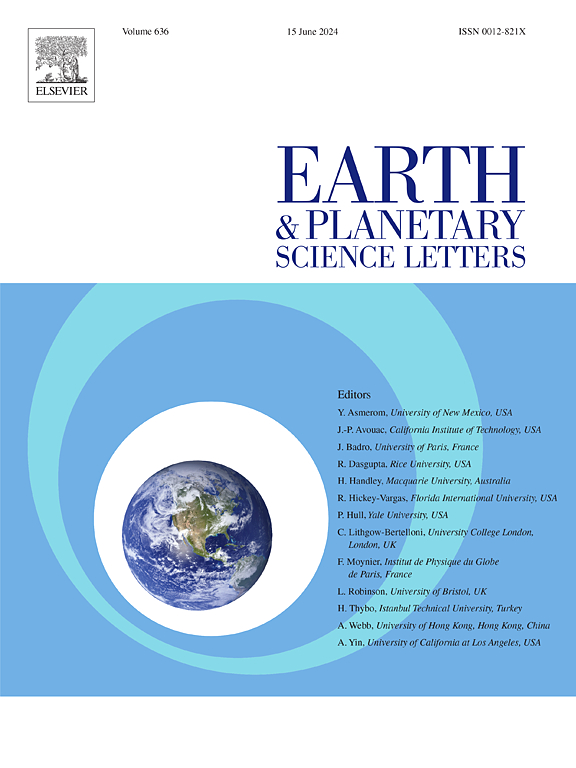平板块俯冲作用形成层状萨斯克克拉顿的磁位测量学证据
IF 4.8
1区 地球科学
Q1 GEOCHEMISTRY & GEOPHYSICS
引用次数: 0
摘要
2021 年和 2022 年,在萨斯克克拉通的 56 个地点收集了长周期磁触电(MT)数据。这些数据与现有的宽带数据相结合,经过反演,生成了萨斯克克拉通和跨哈德逊造山带(THO)的三维电阻率模型。该模型揭示了一些向东北方向延伸至地幔岩石圈的导电地壳结构。在地幔岩石圈中,这些导体在 70-85 千米的深度范围内凝聚成一个单一的大型低电阻率异常,称为北萨斯克克拉通(NSC)导体。NSC 导体的电阻率归因于硫化物沉积在平坦板块之间的界面上,该板块是在马尼基万洋闭合期间增生到前 THO 萨斯克克拉顿岩石圈底部的。金伯利岩沿着 NSC 导体的边缘喷发。导体的边界很可能是平板块俯冲过程中形成的深层断层和地幔地层边界,使金伯利岩熔体得以上升。东北走向导体的电阻率可解释为在海洋闭合和奥陶纪过程中,过去的流体或熔体流动所沉淀的石墨和硫化物。其中一些导体位于已知矿区和趋势的下方,可能是区域基本金属和贵金属矿床的来源途径。其他导体则可能代表着以前未知的矿化区域。其中许多导体与主要的区域断层和剪切带有关,这些断层和剪切带可能是有助于引导金伯利岩和成矿流体的深层特征。在萨斯克克拉顿以西突出的东北走向导体中,有一条与之前报告的北美中原(NACP)导体相对应。新模型显示,该导体在北纬 54 °处突然终止,在模型的更南端没有观测到。这表明,北美中原导体在空间上并不像以前认为的那样连续,这表明形成 THO 的构造过程并不像现有构造模型中显示的那样沿走向一致。其中一个东北走向的异常点与 NSC 导体的联系表明,在 THO 形成的过程中,萨斯克克拉通下面可能发生了以前未曾认识到的东倾俯冲阶段。本文章由计算机程序翻译,如有差异,请以英文原文为准。
Magnetotelluric evidence for the formation of the layered Sask Craton by flat slab subduction
Long-period magnetotelluric (MT) data were collected at 56 locations over the Sask Craton in 2021 and 2022. The data were combined with existing broadband data and inverted to produce a 3-D resistivity model of the Sask Craton and Trans-Hudson Orogen (THO). The model reveals a number of northeast striking electrically conductive crustal structures that extend into the mantle lithosphere. In the mantle lithosphere, these conductors coalesce into a single large low resistivity anomaly in the depth range 70–85 km termed the Northern Sask Craton (NSC) conductor. The resistivity of the NSC conductor is attributed to sulfides deposited along an interface between a flat slab that was accreted to the base of the pre-THO Sask Craton lithosphere during closure of the Manikewan Ocean. Kimberlites have erupted along the margin of the NSC conductor. The boundary of the conductor likely represents deep-seated faults and mantle terrane boundaries formed during flat slab subduction that allowed the ascent of kimberlite melts. The resistivity of the northeast-trending conductors can be interpreted as due to graphite and sulfides precipitated by past fluid or melt flow during ocean closure and orogensis. A number of these conductors are located beneath known mineral districts and trends and may represent source pathways for regional base and precious metal deposits. Other conductors may represent possible, previously unknown, regions hosting mineralization. Many of these conductors are associated with major regional faults and shear zones, which may be deep-seated features that helped to guide both kimberlites and mineralizing fluids. Of the prominent northeast-trending conductors west of the Sask Craton, one corresponds to the previously reported North American Central Plains (NACP) conductor. The new model shows that this conductor abruptly terminates at 54 °N and is not observed farther south in the model. This shows that the NACP is not as spatially continuous as previously suggested, suggesting that the tectonic processes that formed the THO were not as uniform along-strike as shown in existing tectonic models. The connection of one of the northeast-trending anomalies to the NSC conductor suggests that a previously unrecognized phase of east-dipping subduction may have occurred beneath the Sask Craton as the THO was formed.
求助全文
通过发布文献求助,成功后即可免费获取论文全文。
去求助
来源期刊

Earth and Planetary Science Letters
地学-地球化学与地球物理
CiteScore
10.30
自引率
5.70%
发文量
475
审稿时长
2.8 months
期刊介绍:
Earth and Planetary Science Letters (EPSL) is a leading journal for researchers across the entire Earth and planetary sciences community. It publishes concise, exciting, high-impact articles ("Letters") of broad interest. Its focus is on physical and chemical processes, the evolution and general properties of the Earth and planets - from their deep interiors to their atmospheres. EPSL also includes a Frontiers section, featuring invited high-profile synthesis articles by leading experts on timely topics to bring cutting-edge research to the wider community.
 求助内容:
求助内容: 应助结果提醒方式:
应助结果提醒方式:


